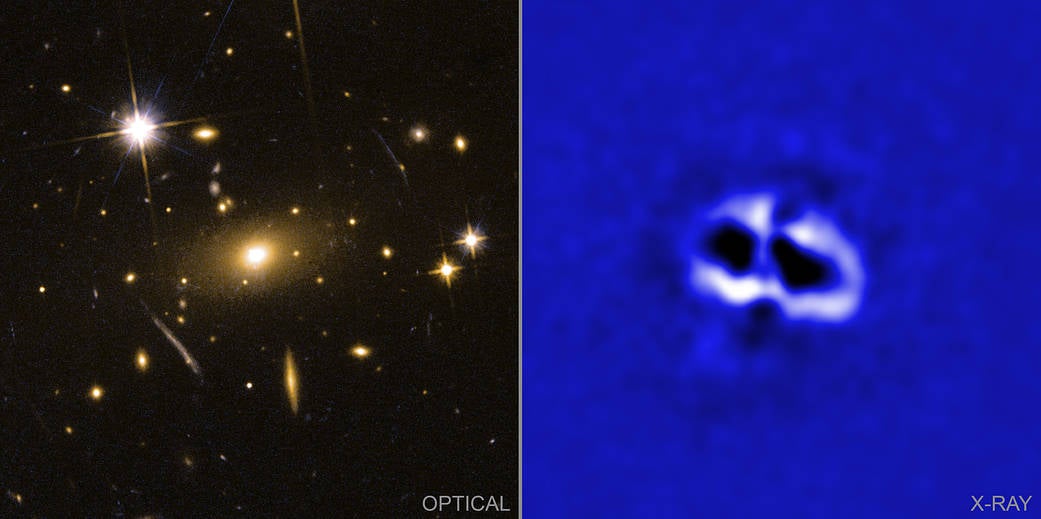NASA’s Chandra spacecraft spies clover-shaped voids left by supermassive black holes
A galaxy cluster called RBS 797, 3.9 billion light-years away, contains unusual dark spots.

Large dark spots form the shape of a four-leaf clover in the middle of a cluster of galaxies, according to a new study. It’s a cosmic first–the only time scientists have observed two sets of such dark spots, which are formed by black holes, in the same place.
The dark spots are created when emissions from supermassive black holes at the center of galaxies produce huge pairs of “lobe” shapes. These structures show up in the radio spectrum but are dark voids in the X-ray spectrum. For the first time, researchers have found a set of four lobes in the same spot.
Multiple sets of lobes in the same area isn’t unheard of, but they’re typically different sizes and further apart than this clover-shape feature. “The peculiarity of our system is that the four lobes are all at the same distance from the center,” says Francesco Ubertosi, a PhD student in astrophysics at the University of Bologna in Italy who uses X-rays to study clusters of galaxies. Ubertosi led the new study, published in The Astrophysical Journal Letters.
All of these lobes seem to be the same size and based around a central axis. This is evidence that the two pairs of lobes formed around the same time.
The galaxy cluster in question, called RBS 797, is 3.9 billion light-years from Earth and has been well studied already. Researchers have long known that radio lobes existed there. In particular, Ubertosi’s work builds off a 2013 study of the region, which found that X-ray voids overlapped with the lobes—places that were dark to the Chandra X-ray Observatory. This supported the idea that a black hole there had “excavated” the surrounding matter out of the region, Ubertosi says.
The main question Ubertosi and his team tried to answer was: could they find gaps in the X-ray data to match the shapes of the extra radio lobes? “It’s like we have one story,” Ubertosi says, “but two different ways to tell it,” and the views in radio and X-ray should match.
A supermassive black hole usually shoots particles from its top and bottom in two high-speed streams called relativistic jets. A jet expands after it reaches a certain distance, and “pushes away the gas that we see in the X-rays that is around it,” Ubertosi says. The jet carves out a path in surrounding matter and “creates the bubble-like depressions in the X-rays,” he says.

The X-ray voids can be compared to a person blowing bubbles underwater, says Michael McDonald, an astrophysicist at MIT who studies the evolution of supermassive black holes and the stuff surrounding them, and was not involved in the study. “You could see the bubbles in the water…or if you could detect the air somehow,” he says. Seeing the gaps in the water is like detecting the voids in X-ray voids and measuring the gases in the bubbles is like detecting the radio waves.
In 2019, Ubertosi’s supervisor was awarded time on the Chandra space telescope to check out the object in more detail. And when they got the results, they saw four voids in Chandra’s X-ray readings, matching the four radio lobes.
What’s more, they tried to measure the difference in age between the two sets of lobes and found they’re less than 10 million years apart in age—which isn’t too different on a galactic timescale, Ubertosi says.
[Related: Watch a black hole devour simulated stars]
Their small age gap supports two possible explanations, which were also put forth by the authors of the 2013 study when they found the additional set of lobes in the radio spectrum. Explanation one: that two supermassive black holes orbiting close together became active at the same time and caused these lobes. Or two: that a single black hole was thrown off its axis, probably when it merged with another black hole, and rotated, spewing its jets in a new direction. But those extra lobes hadn’t been seen in any past X-ray surveys, which likely weren’t long enough exposure, Ubertosi says.
Both ideas hold up in terms of theory, McDonald says, but he finds the double black hole idea “more appealing” because it could represent another way of studying black hole mergers in addition to gravitational waves.
The team’s results are compelling, but a two or three times finer image would make them certain, McDonald says. The work is “the best we can do without the launch of a new multi-billion dollar X-ray telescope,” he says.
Researchers will continue to probe galaxy cluster RBS 797. In Ubertosi’s next project, he hopes to settle the debate over whether the four-leaf clover was made by two black holes, or one.
